Can You Make Sprite With Pine Needles?
Pine needles are a ubiquitous feature of forests and have long been used for medicinal purposes.
They are known to be rich in antioxidants, vitamin C, and other beneficial compounds that can boost the immune system and improve overall health.
However, not many people know that pine needles can also be used in culinary applications, including as an ingredient in soft drinks like Sprite.
The idea of using pine needles in a carbonated beverage may sound unusual at first but is not entirely new.
In fact, some commercial soft drink manufacturers have experimented with incorporating natural flavors into their products, including pine needle extract.
This article will explore the process of making Sprite with pine needles, from understanding their health benefits and flavor profile to infusing the extract into the drink and adjusting its taste.
We will also provide tips on serving and enjoying this unique beverage while encouraging readers to experiment with other pine needle drinks and recipes.
Key Takeaways
- Pine needles are a rich source of antioxidants, vitamin C, and other beneficial compounds that can improve overall health and boost the immune system.
- Pine needle extract can be used to make a refreshing and invigorating soft drink like Pine Needle Sprite by carefully combining it with Sprite in specific ratios and adjusting the sweetness to balance out the bitterness of the pine needles.
- Pine needle oil contains compounds like alpha-pinene and beta-pinene that have anti-inflammatory effects on the body and can help fight off infections.
- Pine needle extract should be used with caution as it may cause allergic reactions, especially in those who are sensitive to certain types of plants.
The Health Benefits of Pine Needles
The consumption of pine needle tea has been associated with various health benefits, including anti-inflammatory and antioxidant properties.
Pine needles contain high levels of vitamin C, which can help boost the immune system and protect against colds and flu.
Additionally, pine needle tea is known to have antibacterial properties that may help fight off infections.
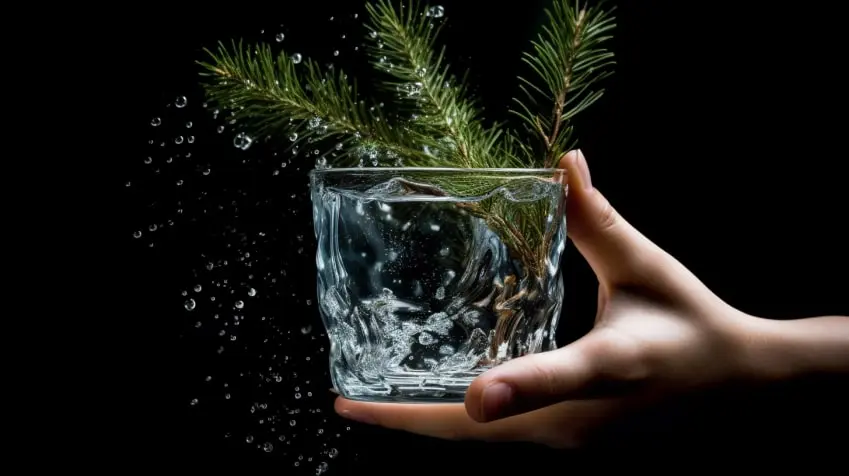
Pine needle oil is another product that has gained popularity in recent years due to its potential health benefits.
It is extracted from the needles of certain species of pine trees through a process known as steam distillation.
Pine needle oil contains compounds such as alpha-pinene and beta-pinene, which are believed to have anti-inflammatory effects on the body.
Some studies have also suggested that these compounds may help reduce pain and improve respiratory function. However, more research is needed to fully understand the potential health benefits of pine needle oil.
Understanding the Flavor of Pine Needles
One potential characteristic of pine needles that may be relevant to their use in flavoring is the presence of terpenes, which contribute to their distinct aroma and taste.
Terpenes are organic compounds found in many plants, including conifers like pine trees.
They are responsible for the unique scent of pine needles, as well as other aromatic plants like lavender and citrus.
In addition to providing a pleasant fragrance, terpenes also have a number of health benefits, including anti-inflammatory and anti-fungal properties.
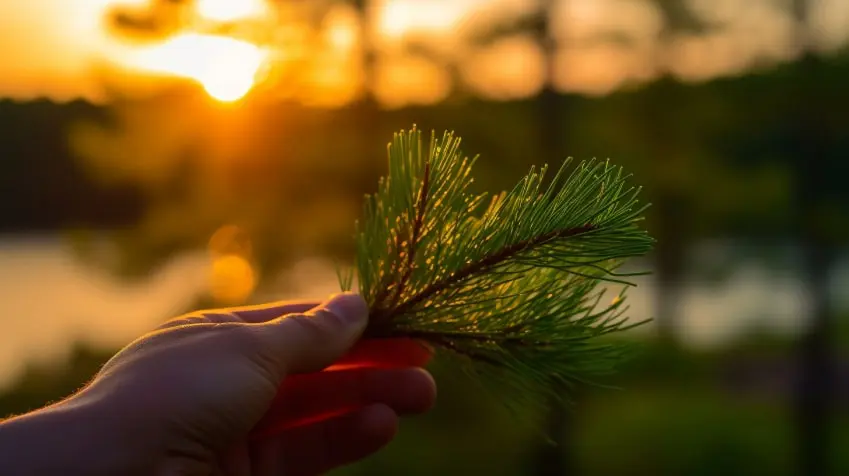
Exploring pine needle tea and using pine needle seasoning for food have both become increasingly popular in recent years.
Pine needle tea is made by steeping fresh or dried needles from various species of pine trees in hot water.
This beverage has been consumed for centuries by indigenous peoples around the world for its medicinal properties, such as boosting immunity and aiding digestion.
Pine needle seasoning can be used in place of traditional herbs like rosemary or thyme to add a unique flavor profile to dishes such as roasted chicken or grilled vegetables.
When used sparingly, it can provide a subtle hint of fresh forest air to any meal.
The Process of Making Pine Needle Extract
Extracting the flavor and medicinal properties of pine needles involves a process that requires grinding the needles into a fine powder and steeping it in alcohol or oil to release the desired compounds.
This process is known as making pine needle extract, which can be used for various purposes such as flavoring food, as an ingredient in natural remedies, or as a fragrance in cosmetics.
Harvesting techniques play a crucial role in ensuring the quality of pine needle extract.
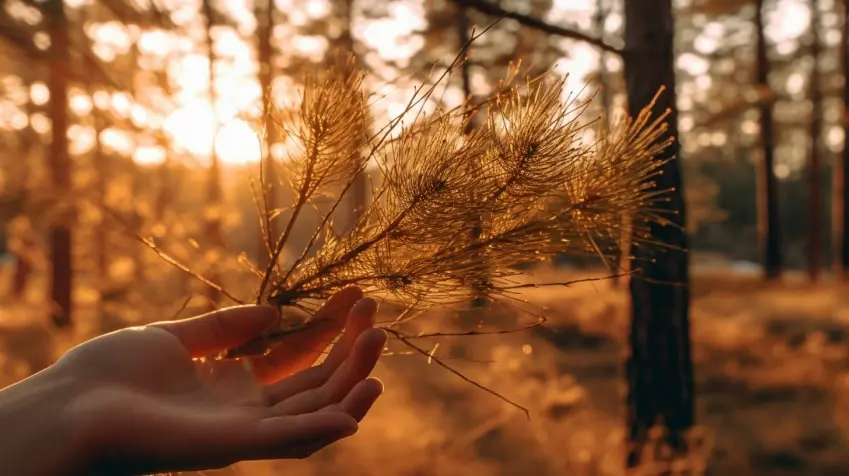
It is important to harvest only healthy and mature needles from a tree that has not been exposed to any harmful chemicals or pollutants.
Additionally, potential side effects should also be considered when using pine needle extract since it contains compounds that may cause allergic reactions, especially to those who are sensitive to certain types of plants.
As with any natural remedy or supplement, it is always best to consult with a healthcare professional before use.
Infusing Pine Needle Extract into Sprite
Infusing the essence of pine needles into a carbonated beverage like Sprite is akin to adding a refreshing and invigorating forest aroma to the drink.
The process of infusing pine needle extract into Sprite involves carefully combining the two ingredients in specific ratios.
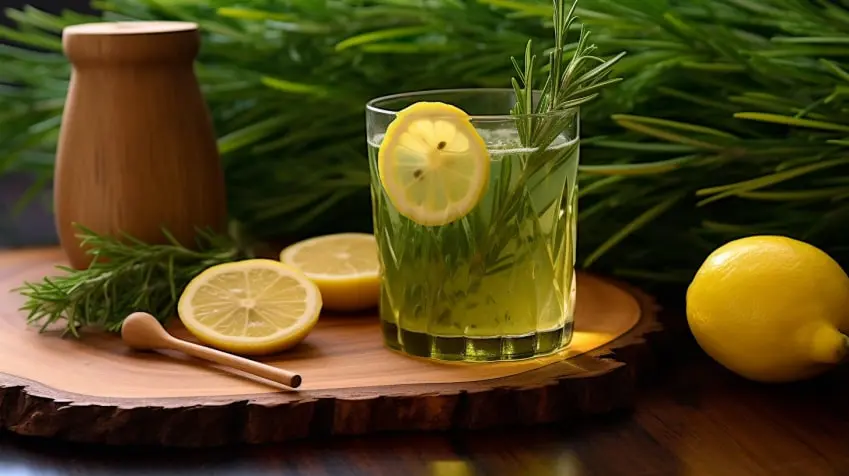
Pine needle extract can be made by boiling pine needles in water, which creates a flavorful tea that can be used as the base for many different beverages such as pine needle cocktails.
To infuse Sprite with pine needle extract, one must first prepare the extract by steeping freshly harvested pine needles in hot water.
Once the tea has cooled, it can be added to Sprite in small amounts until the desired flavor profile is achieved.
| Pine Needle Extract | Sprite |
|---|---|
| 1 tbsp | 12 oz |
| 2 tbsp | 16 oz |
| 3 tbsp | 20 oz |
Overall, incorporating pine needle tea into carbonated beverages like Sprite provides an interesting twist on traditional flavors and introduces natural elements into everyday drinks.
With careful experimentation and attention to detail when measuring out ingredients, anyone can create a unique and refreshing drink that highlights the distinct flavor of pine needles.
Adjusting the Flavor of Pine Needle Sprite
The complexity of flavor in Pine Needle Sprite can be fine-tuned by adjusting the ratio of pine needle extract to Sprite, allowing for a customized taste experience.
Adding sweeteners such as sugar or honey can help balance out the bitterness of the pine needles and create a more palatable drink.
The amount of sweetener added will depend on personal preference, but it is important not to overpower the natural flavors of the pine needles.
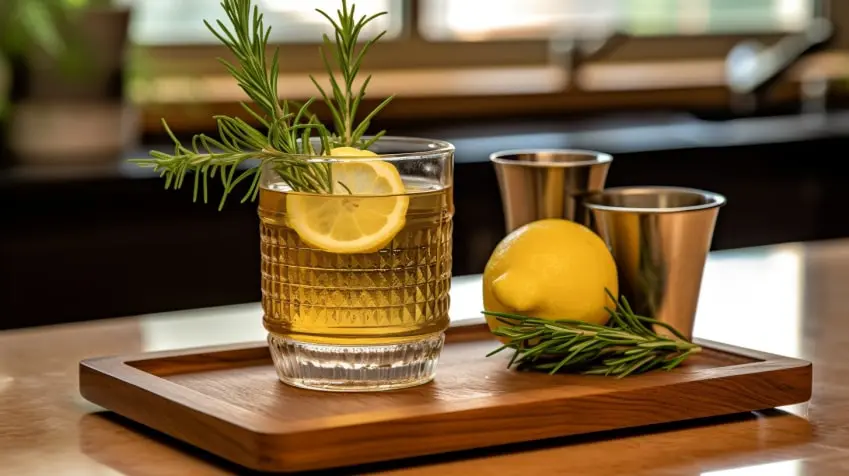
Pairing with other flavors can also enhance the overall taste of Pine Needle Sprite.
Citrus fruits such as lemon or lime can add a refreshing acidity that complements the earthy notes of the pine needles. Herbal flavors like mint or rosemary can also complement and enhance the flavor profile of this unique beverage.
Experimentation with different flavor combinations is encouraged to find a personalized and enjoyable taste experience.
Serving and Enjoying Pine Needle Sprite
To fully savor the unique taste experience of Pine Needle Sprite, it is recommended to serve it chilled and garnished with a sprig of fresh herbs.
This will not only enhance the appearance of the drink but also add a subtle aroma that complements its piney flavor.
Additionally, one can experiment with mixing Pine Needle Sprite with other beverages such as lemonade or grapefruit juice to create new taste sensations.

When garnishing Pine Needle Sprite, using pine needles adds an extra layer of authenticity to the drink and enhances its visual appeal.
However, one should be cautious when selecting pine needles for use in garnishing as some species are toxic and should not be consumed.
It is best to consult with a local botanist or horticulturist before selecting the appropriate type of pine needles for use in garnishing Pine Needle Sprite.
Overall, serving and enjoying Pine Needle Sprite can be a unique culinary experience that offers both novelty and creativity in mixology while staying true to nature’s flavors.
- The crispness of chilled Pine Needle Sprite on a hot summer day evokes feelings of refreshment and rejuvenation.
- The earthy aroma emanating from freshly cut herbs used as garnish adds an element of elegance and sophistication.
- Mixing Pine Needle Sprite with lemonade creates a zesty twist on traditional lemonade that tantalizes the taste buds.
- The slight bitterness in grapefruit juice accentuates the natural sweetness present in Pine Needle Sprite, creating an invigorating blend.
- Garnishing with appropriately selected pine needles gives off an air of rustic charm that transports drinkers into nature’s embrace.
Experimenting with Other Pine Needle Drinks and Recipes
One can explore a multitude of possibilities by incorporating pine needle extract into various cocktail recipes, adding a distinctive touch to classic drinks like gin and tonic or creating entirely new concoctions.
Pine needle tea, for example, is a popular way to enjoy the flavor and health benefits of pine needles.
This beverage is made by steeping fresh or dried pine needles in hot water, often with added honey for sweetness.

It is said to have anti-inflammatory properties and can be consumed as a natural remedy for colds and flu.
Incorporating pine needle extract into cocktails can also elevate the taste profile of traditional drinks.
For instance, adding pine needle syrup to a gin and tonic can add depth to the flavor while enhancing its botanical notes.
Similarly, mixing pine needle-infused vodka with cranberry juice creates a unique twist on the classic Cosmopolitan.
With the versatility of pine needle extract, there are endless opportunities for experimentation in both tea and cocktail recipes alike.
| Pine Needle Tea | Pine Needle Cocktails |
|---|---|
| Made by steeping fresh or dried needles in hot water | Can add depth to traditional drinks such as Gin & Tonic |
| Has anti-inflammatory properties | Mixing with cranberry juice creates unique twist on Cosmopolitan |
| Consumed as natural remedy for colds & flu | Adds distinctive touch to classic cocktails |
| Often sweetened with honey | Endless opportunities for experimentation in both tea & cocktail recipes |
Frequently Asked Questions
How do pine needles affect the environment?
Pine needles have a significant impact on ecosystems, serving as habitat and food for various species. The sustainability of using pine needles in culinary practices requires careful consideration to balance human needs with environmental impacts. A hyperbole: Pine needles are a crucial component of forest ecosystems, supporting life in myriad ways.
Can pine needles be used for anything other than flavoring drinks?
Pine needles can be used for various craft projects and natural remedies due to their antibacterial and anti-inflammatory properties. They are often added to soaps, candles, and bath salts. However, they are not typically used for flavoring drinks like Sprite.
Are there any risks or side effects to consuming pine needle extract?
As the saying goes, “all things in moderation.” While pine needle extract may offer potential medical benefits, consuming excessive amounts can result in adverse effects. It is important to adhere to recommended dosage recommendations and consult a healthcare professional before use.
What is the history of using pine needles in culinary practices?
The use of pine needles in culinary practices has a long history, with evidence of consumption dating back to ancient societies. Pine needle tea and seasoning are common uses, providing unique flavors and potential health benefits due to their high antioxidant content.
Can pine needles be used to make other types of carbonated beverages besides Sprite?
Pine needles have been used to make various carbonated beverages, including Pine Needle Soda and Spruce Beer. Alternative uses of pine needles include tea, flavoring for meats, and medicinal purposes due to their high vitamin C content. Health benefits of pine needle consumption include anti-inflammatory properties and immune system support.
Conclusion
This article explored the possibility of creating a unique and healthy beverage by infusing pine needle extract into Sprite.
Pine needles have numerous health benefits, including being high in vitamin C and antioxidants.
The process of making pine needle extract involves steeping the needles in hot water and allowing them to cool before straining out the liquid. This extract can be added to Sprite for a refreshing twist on a classic drink.
To adjust the flavor of pine needle Sprite, one can experiment with adding different sweeteners or citrus fruits.
It is important to note that while pine needles are generally safe for consumption, they should be harvested from non-toxic species and thoroughly cleaned before use.
It is interesting to note that according to a study published in the Journal of Food Biochemistry, extracts from various parts of the pine tree (including needles) contain compounds that have antimicrobial properties against common foodborne pathogens such as E.coli and Salmonella.
This further emphasizes the potential health benefits of incorporating pine needles into our diets in creative ways like making homemade drinks or incorporating them into recipes.
With some experimentation and caution, individuals can enjoy the unique flavor and potential health benefits of pine needle Sprite as well as other creative uses for this versatile plant material.
